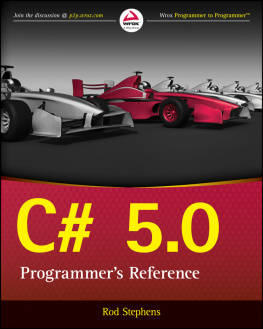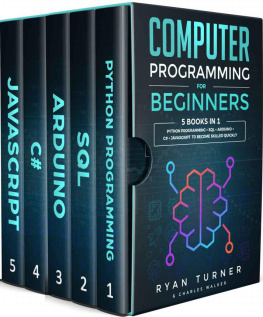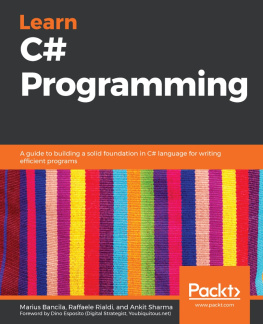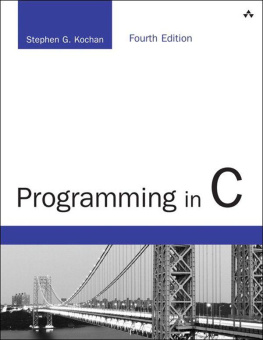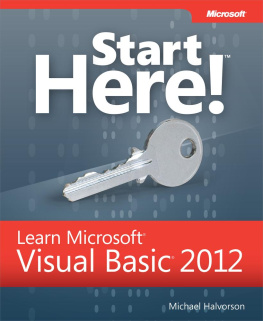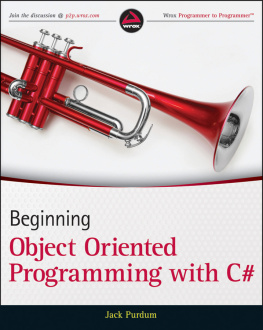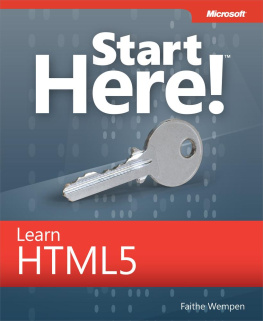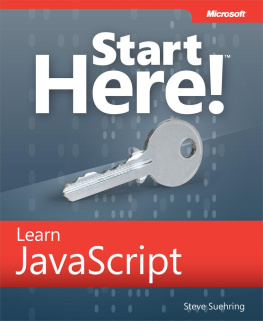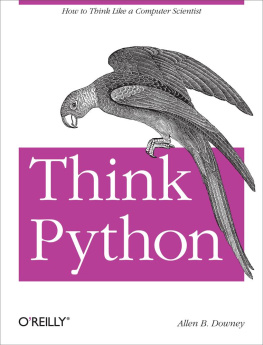Start Here! Fundamentals of Microsoft .NET Programming
Rod Stephens
Copyright 2011 Rod Stephens
Microsoft Press books are available through booksellers and distributors worldwide. If you need support related to this book, email Microsoft Press Book Support at .
Microsoft and the trademarks listed at http://www.microsoft.com/about/legal/en/us/IntellectualProperty/Trademarks/EN-US.aspx are trademarks of the Microsoft group of companies. All other marks are property of their respective owners.
The example companies, organizations, products, domain names, email addresses, logos, people, places, and events depicted herein are fictitious. No association with any real company, organization, product, domain name, email address, logo, person, place, or event is intended or should be inferred.
This book expresses the authors views and opinions. The information contained in this book is provided without any express, statutory, or implied warranties. Neither the authors, OReilly Media, Inc., Microsoft Corporation, nor its resellers, or distributors will be held liable for any damages caused or alleged to be caused either directly or indirectly by this book.
Microsoft Press
Introduction
Programming languages do one very simple thing: they allow you to write programs that tell the computer what to do. You can tell a computer to read a value from the keyboard, add two numbers, save a result in a file on the hard disk, or draw a smiley face on the screen.
No matter what programming language you use, the underlying commands that the computer can execute are exactly the same. Whether you use Java, C#, Microsoft Visual Basic, COBOL, LISP, or any other language, you can make the computer perform roughly the same tasks. Two languages may have very different syntaxes, and some languages make some tasks easier than others, but the fundamental operations they can perform are the same. All these languages can carry out numeric calculations and manipulate files; unfortunately, none of them can reliably pick lottery winners. (If you write a program that can, let me know!)
At a more conceptual level, programming concepts have been refined over the years until most modern languages share a common set of fundamental concepts, such as variables, classes, objects, forms, menus, files, and multiprocessing. Dont worry if you dont know what these arethe purpose of this book is to provide more information about such terms and concepts.
Because programming languages share so many operations and concepts, programming books tend to cover the same topics as well. Books about databases or graphics cover these specialized topics in great detail. Different authors may place emphasis on different subjects, but theres a lot of overlap, particularly in beginning and general how to program books. Every one of these books explains what a variable is, how to create objects, and what a text file contains.
All this means that if you want to learn more than one programming language (a practice that I highly recommend), youre going to encounter much of the same material repeatedly. Even if you skim the familiar sections, you still have to pay for the content. You may start with a 600-page book about Visual Basic programming. Later, when you buy a 500-page C# book, youll discover that 200 of those pages cover things you already know. Next, when your boss decides you need to learn LISP, youll find that your new 550-page book contains 100 pages that you already know. (There are a lot of differences between LISP and the other two languages, so there will be less overlap if you shift to that language.)
This edition of the Start Here! series changes all that. Rather than making each Start Here! book cover the exact same topics, those common topics have been moved into this volume for easy reference. Now if you read Start Here! Learn Microsoft Visual C# 2010 Programming or Start Here! Learn Microsoft Visual Basic Programming, you wont need to rehash the exact same topics. Instead, those books refer you to this one for background information, such as how disk buffering works, freeing the other books to focus on language-specific issues.
There still will be some overlap between any books about different languages. For example, Visual Basic and C# both let you read and write disk files. Although Start Here! Fundamentals of .NET Programming explains in general what disk files are and how programs interact with them, the other books still need to explain the syntax for the code that their respective languages use to read and write files.
Note that this book doesnt necessarily cover every last detail of each background topic. It just gives you the information you need to understand how programs fit into a larger context so that you can get the most out of them. For example, this book explains some important programming issues relating to disk drives, but it doesnt explain in detail how disk drives work.
Moving underlying common topics into this separate book provides several benefits, including the following:
Other Start Here! books can spend less time on the background material covered in this book and more time on language-specific issues. Those books can rely on and refer to this book to provide extra detail as needed.
This book provides more room for, and spends more time on, basic concepts that beginning programming books often must gloss over to make room for language-specific concepts.
This book provides a single location for learning about general computer topics, without focusing on a particular language. This is important because it can give you a broader understanding of what you can make computers do easily and what might be difficult to make a computer do, regardless of which programming language you choose.
This book can act as an enhanced glossary, giving you a place to look for explanations of common computer terms. A normal glossary briefly defines key terms, but in addition, the rest of the book provides much more detail about important concepts.
Who Should Read This Book
This book is for anyone who wants a basic understanding of computers and the environments in which programs operate. It provides background information that is useful when you are trying to learn to use any programming language. It also provides information that can help you understand how programs work in general. For example, it explains what multithreading is and why multi-core computers may not always perform much better than single-core systems.
Assumptions
This book does not assume that you have any previous programming experience. In fact, it doesnt even assume that you have a computer! Instead, this book is about understanding computers and programs in general, and Microsoft Windows and .NET concepts in particular, not about writing programs in a specific language.
This book is intended for two main audiences: those who want to learn a new programming language, particularly those who are reading one of the other books in the Start Here! series, and those who want a better overall understanding of computers.
Although the content of this book is as general as possible, it is not primarily intended as a stand-alone work; instead, its intended as an accompanying volume for use with other Start Here! books, which cover a range of languages and technologies. Most of the information youll find here applies to computers and programs running Windows, but many of the concepts also apply to other operating systems, such as Unix, Linux, or OS X. Sometimes, however, specificity aids clarity, so in some places this book is targeted toward Windows.


